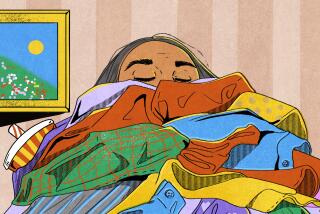Helping Clutter Bugs Contain Themselves
To find Jeremy Ridman’s problem, just look near the end of the couch in his Irvine home. Or on the shelves that line his den. Or that messy spot below his side of the bed. You’ll see magazines, stacks and stacks of them. Some a few years old.
“He can’t seem to throw any written material away,” says his wife, Katharine. “I’ve tried to sneak them [into the trash], but he won’t have it.”
Jeremy just shrugs it off. “I enjoy magazines and can’t seem to part with them. I can remember stories and articles in most and may want to go back” to read them.
The tough-love approach would be to yank them away, letting him sweat through his withdrawal. Another solution is offered by Peri Wolfman and Charles Gold in their book “A Place for Everything: Organizing the Stuff of Life” ($25, Clarkson Potter Publishers, 1999), which tells people how to manage clutter and make the most out of storage space.
The book, with basic problem-solving tips for every area of the house, was welcome news to the Ridmans, especially Katharine. Apparently, it also clicked with several other Orange County residents who were asked to talk about their troubles finding enough room for all their this and thats.
The Written Word
Jeremy Ridman, whose interest in reading makes sense, considering he’s worked in advertising and public relations for several years, admits his keeper tendencies are not reserved for magazines. He hoards books as well. And not just classics but almost any old hardback or new paperback that comes his way.
“If you’re into books, it’s hard to get rid of them,” he says. “I give some to friends but mostly keep them. Yeah, they stack up.”
First off, Wolfman and Gold write, magazines and books crave shelves. A no-brainer there, but ensuring the shelving looks smart requires some planning. The authors are big on shelving but only if done with the overall look in mind.
For instance, once you (or a professional) put shelves in a room or closet, consider what’s going to be put on them. If, say, the shelves are in the bathroom and will hold mostly white towels, then paint them blue or some other contrasting color.
Wolfman and Gold also suggest putting a long shelf above the door in rooms, making it easy enough to reach but above eye level. Narrow shelves grouped side by side also tend to look better than long ones.
Of course, the Ridmans can put magazines and books on these shelves. The dining room is a good spot for a whole wall of shelves containing books because of the cozy library feel it creates. Wolfman and Gold recommend putting magazines in baskets or fancy boxes stacked on sliding shelves under a table so they’re accessible but not obvious.
The authors say magazines can also be put in leather bags or simple purses as living room accents. Metal or wicker trunks can hold them as well and serve as a corner eye-catcher.
Collectibles? Sure.
Mona Lison of Seal Beach also has a hard time tossing stuff out. No problem with books or magazines, though; she tends to keep kitchen items such as cutlery. And then there are odd things, such as no-longer-used prescription eyeglasses and sunglasses.
“Sure, I’ve given some [flatware] to charities and friends, but many were gifts, so I’ve ended up holding onto them,” Lison says, then laughs. “As for the glasses, I’m not sure why I’ve kept them.”
Well, Wolfman and Gold say to enjoy them, even turn them into mini-exhibits. Basically, the authors advise making collections of favorite objects--glasses, perfume bottles, cigarette lighters, breadboards, vintage men’s ties, whatever--and putting them on display.
“Tastes change, prescriptions change,” Wolfman and Gold write. “Sometimes we just buy multiple pairs of eyeglasses. Gather them together in a leather tray and presto!--a collection.”
The pieces should be organized carefully, even artistically, for the best effect, the authors said.
For knives, try putting them in vases and lining them up along the back of a kitchen counter. When you run out of room in your drawers, try displaying your cutlery in earthen pitchers or pottery.
Another idea: search for weather-aged toolboxes and stick flatware, as well as other kitchen items, in them.
All Made Up
Michelle Pinter considers herself and her husband, Jason, neat, practical folk. They don’t have too many problem spots in their Westminster home, but the small bathroom has vexed her for years.
“There’s not enough room, especially in the medicine cabinet, for all the things, his and mine,” she says. “So what happens is we have them out, and it just turns our counters into a mess.”
For starters, the authors recommend buying woven baskets and trays. Put many of the items, from toiletries to prescriptions, in the covered baskets and place them out of the way, possibly under the sink. For makeup, arrange brushes and pencils in fancy, maybe metal, cups or small woven or glass trays.
“We don’t even have room for the mouthwash, [so] it just sits out there. I don’t like the way it looks,” Pinter says.
Wolfman and Gold suggest pouring enough mouthwash into a decanter to use and storing the bottle somewhere else.
They also recommend being more determined about getting rid of junk on a regular basis.
“A well-maintained medicine cabinet is the most crucial space of all,” the authors write. “The trick here is to keep weeding out out-of-date makeup, medicine, unguents and potions.”
Out With the Old
Frank Roberts finds it difficult to discard old clothes. He has shirts, ties and pants that are more than a decade old, just hogging space in his closets and drawers.
“I don’t even wear any of those, but I still have them,” he says. “I have to be more disciplined about tossing them.”
The authors have a simple strategy for those who are bad about discarding.
First, get a bunch of new, pristine white hangers. Then, take the time to move clothes from the old hangars to the new, analyzing each piece to determine if you’ll ever really need it.
Also, refold drawer items with the same critical eye.
“At the end,” the authors write, “you’ll have a gorgeously tidy closet with space to fill up again and bundles of usable clothes for the thrift shop.”
(BEGIN TEXT OF INFOBOX / INFOGRAPHIC)
Odds and Ends
Space still too tight? Here are a few other general storage tips as suggested by Peter Wolfman and Charles Gold in their book “A Place for Everything: Organizing the Stuff of Life.”:
* Toilet paper: Fighting with your mate over whether the roll should start from the top or the bottom? If so, you probably need more help than this book provides. But the authors recommend throwing out the roller, finding a nice bucket, woven or otherwise, and filling it with toilet paper rolls.
* Spices: An attractive way to use and display spices is to do away with the jars they came in. Fill medical test tubes with your favorites, then set them in a metal rack so they can be moved easily around the kitchen and to the supper table.
* Photographs: A good way to have a revolving exhibit of family photos is to get a commercial postcard rack and stick it in the den or living room. Then, you can replace the old with the new as they come. Ask shop owners if they have any old racks or where you can buy one.
More to Read
Sign up for our Book Club newsletter
Get the latest news, events and more from the Los Angeles Times Book Club, and help us get L.A. reading and talking.
You may occasionally receive promotional content from the Los Angeles Times.







